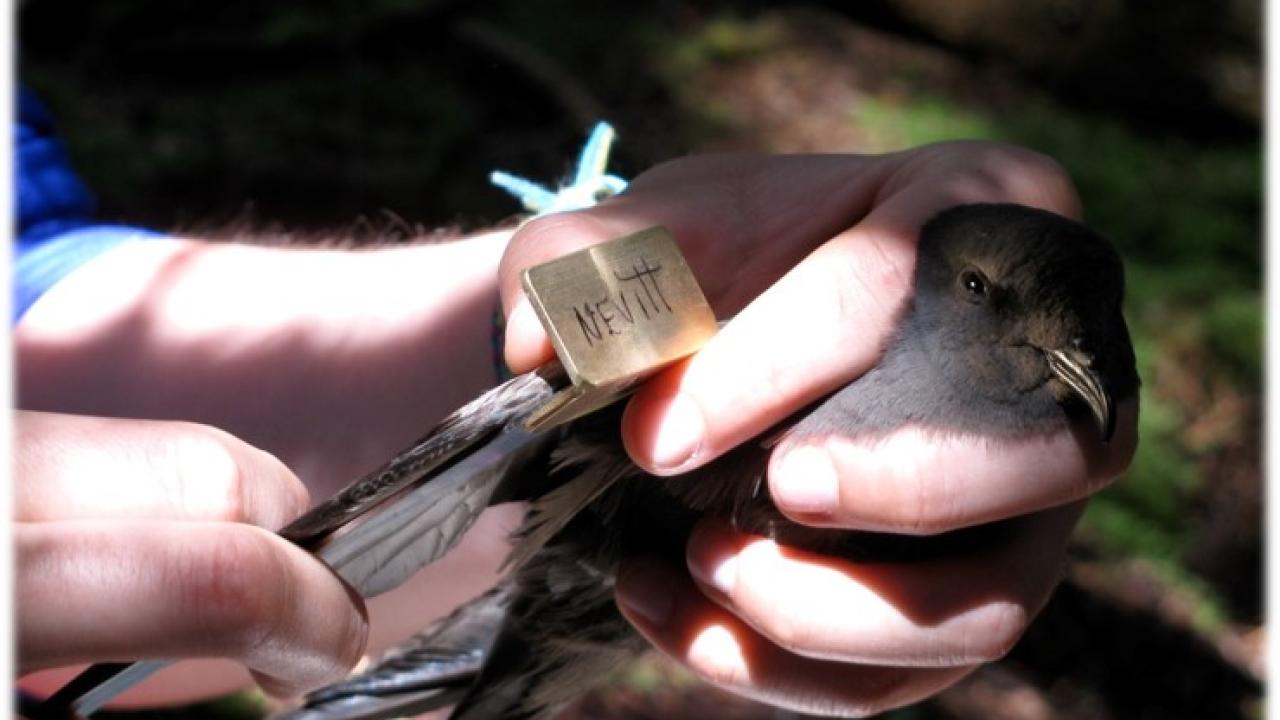
The Scent of a Mate: Seabird Study Provides Insights into Sexual Selection
Quick Summary
- Leach's storm-petrels have an excellent sense of smell and may use it to select mates
- Their selection may be influenced by MHC, a group of genes critical for proper immune system function
- The study revealed males are mating with heterozygous females, which can produce offspring with varied genotypes
What scent attracts a seabird’s mate?
It’s a question on the mind of Professor Gabrielle Nevitt, Department of Neurobiology, Physiology and Behavior. An expert on the chemical senses of birds, Nevitt and members of her lab have been studying Leach’s storm-petrels (Oceanodroma leucohoa) for over 20 years with the goal of making the species a model for chemical ecology in birds.
For some animals, it’s known that individual odor is influenced by the major histocompatibility complex (MHC)—a group of genes critical for proper immune system function. Often, an animal will pick a mate with a dissimilar MHC from its own, the genetic variability increasing its offspring’s resistance to pathogens.
“We and others have shown that some species of petrels can recognize personal scents, and we wanted to better understand the molecular mechanisms that might be driving this ability in birds,” said Nevitt. “MHC has been shown to be involved with personal odor recognition in other organisms, so I thought the MHC was a logical starting point.”
In a new study, funded by the National Science Foundation and appearing in Molecular Ecology, the team relay their findings on the role MHC plays in sexual selection in populations of Leach’s storm-petrels on Bon Portage Island in Nova Scotia, Canada. Sampling close to 2,000 adults and chicks, the researchers found males were less likely to mate with females of a specific MHC genotype. Like many other animals, they seemed to select mates with MHC genotypes different from their own.
Nevitt teamed up with Scott V. Edwards, a professor of organismic and evolutionary biology at Harvard University and an expert in MHC, to characterize the MHC genes in this system. Former graduate student Brian Hoover led the genotyping effort in Nevitt’s lab, with help from neurobiology, physiology and behavior undergraduates and fellow ecology graduate student Sarah Jennings.
“We ended up showing that these birds actually do mate non-randomly based on MHC,” said Nevitt. “And there’s actually one genotype that they seem to avoid.”

The birds of Bon Portage Island
Tube-nosed seabirds, like the Leach’s storm-petrel, have an excellent sense of smell. They use it to find food on the open ocean and to navigate to a home burrow. Generally monogamous, each breeding pair produces a single egg each year. That egg can account for a whopping 22 percent of the female’s body weight.
“These seabirds have a demanding existence where you need both parents pulling their weight to successfully incubate, hatch and fledge a chick,” said Brian Hoover, the study’s lead author and a UC Davis Ph.D. ecology graduate. “Both parents are taking turns incubating eggs, and going on foraging trips to feed the chicks when they hatch.”
Bon Portage Island is home to 35,000 breeding pairs. The research team was therefore able to collect blood samples from 1,078 adults and 925 chicks. They also monitored reproductive success and other aspects of their ecology from 2010 to 2015 for the study. The aim was to collect a sample size large enough to answer their research question with adequate statistical power.
The researchers found males mated less frequently with females possessing the most common MHC genotype in the sample population. The males preferred mating with heterozygous females, which are capable of producing offspring of varied genotypes.
“It was a bit of a surprise to see that MHC was associated with male choice instead of female because that’s usually not the expectation,” said Hoover.
How do the birds know?
No one has yet identified the mechanism for how MHC leads to differences in personal scent.
“We are finding ways to examine chemical profiles of these birds and see whether they can actually smell out the differences in MHC genotypes,” said Nevitt, who’s been studying Leach’s storm-petrels since 1996, first on Kent Island and then Bon Portage Island since 2006.
While homozygous females did possess significantly smaller wings than their heterozygous counterparts, the researchers didn’t report any other substantial bodily differences.
“Science is like a puzzle,” added Nevitt. “Whether it takes a day or a decade, it’s best to be able to make sure you fit the pieces correctly to reveal a picture that makes sense, or scents in this case.”
